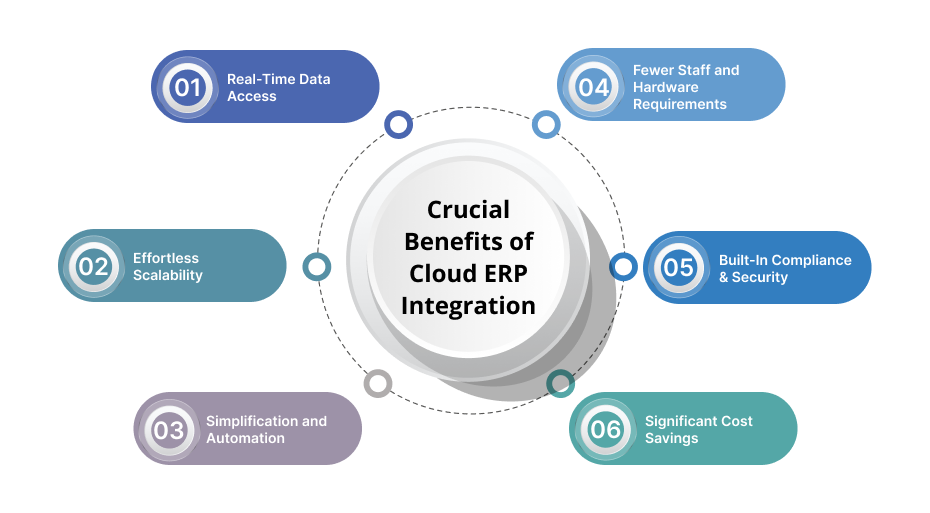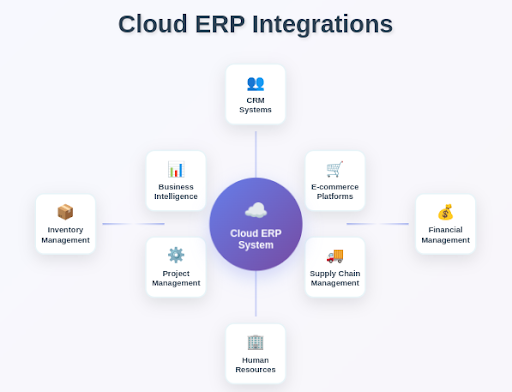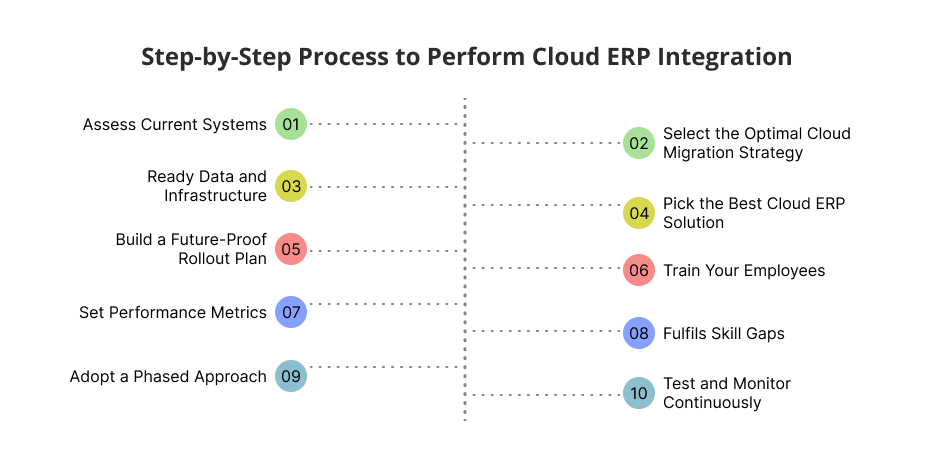Today, integrating your cloud Enterprise Resource Planning (ERP) system with other business tools isn’t just a competitive edge. It’s a necessity for businesses of all sizes. As companies grow, they rely on multiple platforms to manage everything from finance and sales to inventory and customer support.
With a massive amount of data piling up and teams losing sync, there’s a need for a scalable and robust cloud-based ERP system. That’s where cloud ERP integration plays a significant role. It connects your core systems to enable real-time data sharing, smarter insights, and better collaboration across departments.
According to Deloitte, 98% of companies see cloud ERP solutions as critical to their digital transformation strategies. Additionally, future-focused integration can turn scattered software into a unified, agile ecosystem that actually works together.
In this blog, we’ll cover:
- Everything you need to know about the cloud ERP integration
- The key benefits of cloud-based ERP
- Common challenges and how to solve them
- A clear, step-by-step integration process
- Key features to look for
- Cost factors and ROI
What are Cloud ERP Integrations?
Cloud ERP integration connects various cloud-based business applications with your ERP system to create a unified, efficient ecosystem. Instead of managing data on separate platforms, integration ensures that everything works together in real-time.
For example, syncing your customer relationship management (CRM) system with your ERP automates customer data updates across departments. This not only reduces manual work but also keeps financial, sales, and supply chain software data consistent and accurate.
The result is better decision-making, improved productivity, and faster service delivery. In the digital-first era, cloud ERP systems integration is no longer optional; it’s a strategic move to scale and stay agile.
Types of Cloud ERP Integrations
ERP vendors offer ERP software development with both prebuilt and custom options. A reliable choice depends on your IT setup, app environment, and growth plans. Businesses often choose between point-to-point integration, enterprise service bus, or integration platform as a service (iPaaS). Each method has trade-offs, so it’s important to match a cloud ERP implementation with resource needs.
1. Point-to-Point Integration
Point-to-point integration connects two systems directly using custom code. It gives teams more control and works well for simple setups. It’s also budget-friendly for businesses with limited tools.
However, as systems grow, managing multiple connections becomes increasingly challenging. IT teams must build and maintain each link, which adds time, complexity, and long-term costs that can hurt scalability.
2. Integration Platform as a Service (iPaaS)
This offers cloud-based tools to connect apps and data across different environments. It’s built for today’s complex IT setups, especially hybrid and cloud-first models. iPaaS is a go-to solution for managing the rising number of SaaS tools businesses rely on.
With prebuilt connectors, data mapping, and flow automation, it helps streamline integration without heavy custom code. For modern enterprises juggling multiple systems, it delivers flexibility, faster deployment, and lower maintenance compared to traditional cloud integration ERP methods.
3. Pre-Built Cloud ERP Connections
Integrating cloud based ERP solutions is easier now with pre-built functionalities. Many software development companies offer ready-made connectors that need little technical setup. These plug-and-play options are great for common needs, like connecting your eCommerce platform to your ERP system quickly and with less effort.
4. Enterprise Service Bus (ESB)
An Enterprise Service Bus (ESB) acts as a central hub for connecting different software systems, especially in on-premise setups. It uses connectors to standardize data and translate messages between applications.
This middle layer, or communication bus, is great for legacy system modernization. However, ESB isn’t ideal for cloud apps. It still needs a skilled cloud computing services provider to set up and manage everything, which can increase complexity and cost over time.
Crucial Benefits of Cloud ERP Integration
Cloud ERP integration delivers significant value for businesses looking to stay competitive and efficient. It connects systems, streamlines processes, and supports smarter decision-making. Let’s look at the benefits of cloud ERP in detail.

1. Real-Time Data Access
Cloud based enterprise resource planning gives your team instant access to up-to-date information across departments. That means faster decisions, fewer delays, and better alignment with shifting market demands.
2. Effortless Scalability
As your business grows or changes, the cloud ERP integration platform scales with it. Whether you’re adding users, entering new markets, or launching new services, it adapts quickly without needing a full rebuild. Plus, it allows custom workflows to match your operations.
3. Simplification and Automation
One of the key benefits of cloud ERP systems is their ability to simplify and automate processes. By reducing manual data entry, cloud ERP integration helps avoid errors and speeds up tasks. Automating processes also frees up your team to focus on high-value work instead of repetitive tasks.
4. Fewer Staff and Hardware Requirements
Cloud ERP benefits also reduce the need for on-site servers and large IT teams. You cut costs while improving efficiency and can reallocate resources where they matter most.
5. Built-In Compliance & Security
ERP system integration offers robust security and ensures compliance with industry standards, thereby protecting sensitive business data.
6. Significant Cost Savings
With no expensive hardware upgrades or heavy IT maintenance, cloud ERP integration reduces total cost of ownership while improving long-term ROI.
Key Features of Cloud ERP Integration
These top cloud ERP integration features help businesses streamline operations, gain insights faster, and scale securely with confidence.
Feature | Description |
| Real-Time Data Sync | Keeps systems updated instantly for faster, more accurate decision-making. |
| Centralized Information | Combines all business data in one place for better visibility and access. |
| Automated Workflows | Reduces manual tasks by automating key processes and actions. |
| Scalable Architecture | Grows with your business without needing major system changes. |
| Robust Data Security | Protects data with encryption, access control, and compliance tools. |
Use Cases of Cloud ERP Integration
ERP integration connects various business systems according to your company’s structure, objectives, and specific needs. ERP integration use cases involve:

1. CRM (Customer Relationship Management)
CRM tools track customer interactions, purchase history, and contact details. They also store notes from support or sales conversations. This data is valuable for teams across sales, marketing, and customer service. CRM ERP integration helps them improve customer retention, spot new opportunities, and deliver better experiences.
A CRM and ERP development company builds an enterprise software solution that ensures data is instantly available across departments. That means fewer silos, faster decisions, and more effective marketing and sales efforts, all backed by consistent, real-time information.
2. Supply Chain Management
Cloud ERP integration plays a key role in improving supply chain management. It connects systems like sales, shipping, inventory, and manufacturing. This allows teams to manage orders more efficiently, from creation to delivery. If there’s a delay in production or shipping, the system can automatically alert the inventory team.
They can then update warehouses, customers, and managers with new delivery timelines. This level of visibility helps businesses respond faster, reduce disruptions, and facilitate digital transformation in supply chains.
3. Business Intelligence (BI)
Business intelligence (BI) is all about turning data into actionable insights. Companies use BI tools to gather and organize data across departments. This gives decision-makers a clear view of how the business is performing.
- Automates data collection and analysis
- Pulls real-time data from multiple sources
- Helps teams spot trends faster
- Enables quick workflow adjustments
- Improves overall operational efficiency
- Supports smarter, data-driven decisions
4. E-commerce Platforms
Cloud ERP integration in ecommerce platform helps centralize key business data like inventory, product details, order history, and customer information. This central hub keeps your website listings accurate and inventory updates automatic.
- Sends shipping data directly to fulfillment centers
- Eliminates manual data entry
- Helps track best-selling products
- Identifies sales trends quickly
- Enables faster campaign adjustments
- Informs pricing and product decisions
5. Project Management
Integrating your Cloud ERP system with project management tools helps teams stay aligned and on schedule. It gives project managers better visibility into timelines, tasks, and team workloads. This setup makes planning easier and keeps everyone in sync.
Managers can use one system to track progress, share updates, and adjust for any business-wide changes that may affect team workflows. It leads to smoother projects and more predictable outcomes.
Challenges in Cloud ERP Integration and How to Overcome Them
ERP Cloud integration brings considerable benefits, but it also comes with challenges. IT teams may face roadblocks during setup and ongoing maintenance. These issues often depend on the company’s size, systems involved, and the integration method used. Common cloud ERP integration challenges include:
Challenge | What It Is | Solution |
| Limited Timeframes | Tight deadlines for integration can cause rushed decisions and errors. | Use phased rollouts and set realistic timelines with clear milestones. |
| Business Continuity | Integration may disrupt daily operations and customer experience. | Plan during low-impact periods and ensure backup systems are in place. |
| Organizational Change | Teams may resist new systems or struggle to adapt. | Communicate early, offer training, and involve users in the process. |
| Ongoing Monitoring | Without regular checks, systems may fail or perform poorly over time | Set up automated alerts and schedule routine system audits. |
| Data Protection | Sensitive data may be exposed during or after integration. | Use encrypted connections, role-based access, and comply with data standards. |
Step-by-Step Process to Perform Cloud ERP Integration
Migrating your ERP system to the cloud is a major move, and it takes careful planning to get it right. To make the transition smoother, focus on a proven, step-by-step approach.

1. Assess Current Systems
Look at how your existing cloud ERP system performs. Review your processes, software capabilities, and business goals. A simple SWOT analysis helps uncover strengths, weaknesses, and areas that need improvement. It also flags potential challenges before they slow you down.
2. Select the Optimal Cloud Migration Strategy
There’s no one-size-fits-all path, so pick a cloud strategy based on your business needs:
- Lift and shift is fast. You move everything to the cloud with minimal changes. It’s efficient but may miss out on long-term cloud benefits.
- Replatforming requires moderate updates. It’s a middle ground that balances speed and optimization.
- Re-architecting is the most in-depth. It involves redesigning your ERP system to fully leverage cloud capabilities like scalability and automation.
Each option comes with trade-offs. The best-suited choice depends on your goals, budget, and how much change your team is ready to manage.
3. Ready Data and Infrastructure
Preparing for cloud ERP migration starts with getting your data and infrastructure in order. Clean, accurate, and consistent data is essential. Make sure you have reliable backup and recovery systems in place.
Check that your infrastructure meets cybersecurity standards and has enough bandwidth and storage to handle cloud operations.
4. Pick the Best Cloud ERP Solution
Next, choose a cloud ERP solution that fits your business. Look for cloud services companies that offer the best ERP solutions and focus on features that match your top priorities.
5. Build a Future-Proof Rollout Plan
Build a solid cloud migration plan. It should outline technical steps, anticipate possible roadblocks, and keep communication clear across teams. This plan acts as your roadmap, keeping everyone aligned and your migration on track from start to finish.
6. Train Your Employees
User adoption can make or break your cloud ERP integration plan. It’s important to prepare your team early and keep them engaged. Here’s how to make it work:
- Communicate clearly about the benefits and goals of the new system
- Offer role-based training and easy-to-access support materials
- Define responsibilities so everyone knows their part in managing and using the system
When your team understands the value and feels confident using the new tools, adoption becomes much smoother.
7. Set Performance Metrics
You can’t improve what you don’t measure. Define key performance indicators (KPIs) to track how well your ERP cloud system is working. You may need to adjust existing metrics to reflect the cloud’s capabilities, like real-time data or system uptime.
8. Fulfill Skill Gaps
Your IT team may need help adjusting to the new cloud environment. Look for gaps in knowledge and invest in upskilling. The smoother their experience, the better your overall system performance.
9. Adopt a Phased Approach
Start small. Migrate non-critical systems first to test the waters. Learn from early steps before rolling out to high-impact areas.
10. Test and Monitor Continuously
Run full tests on performance, functionality, integration, and application security. Include end users, too. After launch, monitor constantly to maintain performance and catch issues early.
How Much Does Cloud ERP Integration Cost
The annual cost of cloud ERP integration can vary widely, typically ranging from $25,000 to $150,000+. It depends on multiple factors like system complexity, data quality, integrations, and long-term support needs. Below is a cost breakdown.
Cost Factor | Annual Cost (USD) | Details |
| Licensing & Subscriptions | $5,000 – $30,000 | Based on ERP vendor, number of users, and modules selected. |
| ERP System Complexity | $4,000 – $20,000 | More complex systems require deeper integration work |
| Number of Integrations | $3,000 – $25,000 | Depends on how many platforms (CRM, eCommerce, etc.) need integration |
| Data Size & Quality | $2,000 – $10,000 | Large or unclean data adds time and cost to migration |
| Customization Needs | $4,000 – $20,000 | Custom workflows or business rules increase development time |
| Integration Tools Used | $3,000 – $15,000 | iPaaS, middleware, or API tools impact licensing and setup costs |
| Maintenance Costs | $4,000 – $30,000 | Covers updates, bug fixes, monitoring, and ongoing support |
How Can SparxIT Help You With Cloud ERP Integration?
As a leading cloud application development company, we help businesses simplify and streamline their cloud ERP integration process. Our team starts by understanding your goals, current systems, and future plans. We then recommend the best-fit ERP solution and integration strategy.
We handle everything from data migration and platform integration to custom workflows and compliance setup. Our experts also connect your ERP with tools like CRM, eCommerce platforms, and analytics software for real-time insights.
You’ll get end-to-end support, including cloud consulting services, documentation, and post-launch assistance. With SparxIT, you can count on a smooth, secure, and scalable integration that drives real business value.

Partner with Experts
Frequently Asked Questions
Why is Cloud ERP Integration important for modern enterprises?









Cloud ERP integration centralizes data, enhances real-time visibility, and automates workflows. As a result, enterprises improve agility, reduce manual tasks, and make smarter decisions across departments.
What is the difference between cloud ERP and SaaS ERP?
















While both run in the cloud, SaaS ERP is subscription-based and vendor-managed, whereas cloud ERP can be privately hosted, giving businesses more control over customization and data ownership.
What are the most common Cloud ERP integration methods?
















The most used cloud ERP integration methods include APIs, middleware platforms, and custom-built connectors. Each supports secure data flow between ERP systems and third-party applications.
Can legacy systems be integrated with cloud ERP?
















Yes, integrating legacy systems with cloud ERP is possible using APIs or middleware. However, it requires careful planning to ensure compatibility, data consistency, and long-term scalability.
How much does cloud ERP integration cost?
















Cloud ERP integration costs range from $15,000 to $100,000+, depending on system complexity, number of modules, and customizations. Ongoing maintenance and user training also influence total cost
How does cloud ERP integration support business growth?
















Cloud ERP integration supports growth by streamlining operations, improving decision-making, and enabling scalability. Businesses can easily adapt to new markets, automate tasks, and gain real-time insights
How can I calculate the ROI of Cloud ERP integration?
















To calculate Cloud ERP ROI, compare cost savings, efficiency gains, and revenue improvements over implementation costs. Key metrics include reduced errors, labor hours saved, and faster processing times.



